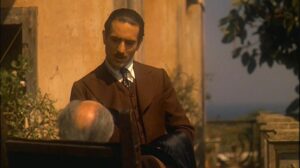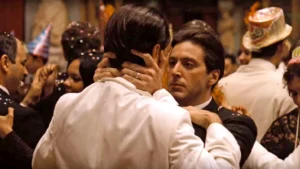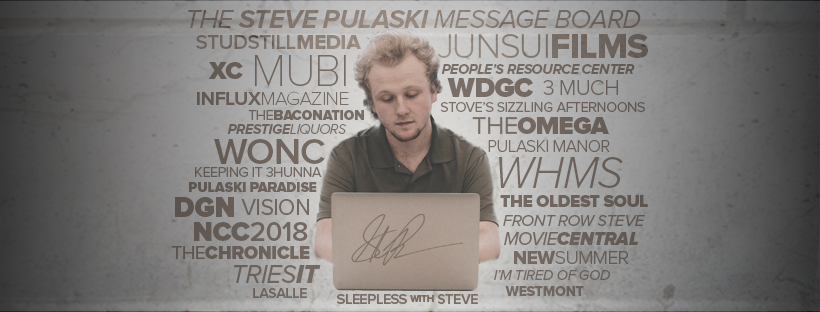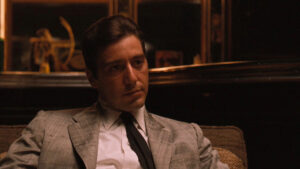Publication Date: 06-18-2025
The Godfather: Part II (1974) review
Dir. Francis Ford Coppola
By: Steve Pulaski
Rating: ★★★★
One of the justifications for The Godfather‘s length (which seems to get shorter every time I see it) is its responsibility to show the glacial progression of Michael Corleone from staunchly individualistic in remaining removed from his family’s mob ventures to pensive and complicit, accepting the throne after the death of his father, Vito. Scenes run long, but more importantly, cuts are infrequent as well; Michael’s change isn’t one that happens overnight. It takes moments of grooming in the form of killing police officers during an evening dinner and intimidating crosstown families by standing confidently on a stoop acting as if you’re brandishing a handgun to scare off a potential mugging — or worse. We couldn’t have gotten the full scope of Michael’s change had it happened in 100 minutes, nor would it have felt authentic. After three hours, we are almost brought to mouth the words, “how could you?” when we witness the iconic ending. But we don’t. We know the answer, or later come to find out.
The Godfather: Part II is an intriguing “rise and fall” story because it’s a story of falling halfheartedly disguised as rising. Had this sequel been the first Godfather, it’s quite possible that the tone of this film would’ve been much different. We might’ve seen Michael Corleone as a figure to envy; a self-made man in pursuit of honing his role as Don. Instead, we see his story as one of selling out and comprising principles in the face of family pressure; one that shows him as caught between his desire to minimize the mob connections of the Corleone family yet haphazardly handle them to the point of bringing more danger to him and his kin. Francis Ford Coppola and co-writer Mario Puzo silently ask a lot of questions during the film and one is plainly carried throughout the film: how do you go back to being a college student and Marine Corp vet and onto a career as a promising lawyer when you’ve done things in your life you’d be hard-pressed to defend your clients for doing?

The film, however, opens with a young Vito Andolini in Corleone, Sicily in 1901, who sees his mother and brother killed trying to avenge the death of his father, who insulted the wrong Don. Young Vito sees a window to escape to New York’s famous Ellis Island, where he becomes Vito Corleone. Sixteen years later, the future head of the Corleone dynasty (played by Robert De Niro) has a wife and kid, and overtime, a name for himself as a legitimate mobster with poise and carefulness. Unlike Michael, his ascent to the top is methodical, with a menacing relationship with Don Fanucci brewing as well as the foundation of the guise of an imported olive oil business that gives them something innocent to say over dinner conversation. On the other hand, Michael’s tumultuous ascent as Don is marked by his attempt to remain loyal to a business partner (Lee Strasberg) despite the partner not being so loyal to his family, as well as a move to Nevada in lieu of an attempt on him and his pregnant wife (Diane Keaton). His head swells to the point of being domineering towards his young brother, Fredo (John Cazale), and only loyal to his adopted brother, Tom (Robert Duvall), which creates friction between the Corleone family, who already feels like they’re being further nudged out of the picture by competing families.
Coppola artfully interweaves these two narratives in and out of one another; not an easy thing to do when both could sustain feature films of their own with the same 200 minute length. While maybe not as precise or as broadly coherent as its predecessor, The Godfather: Part II‘s ambition as both a followup to one of the greatest films ever made as well as one that creates two involved storylines makes it sturdy enough to stand on its own as a compelling, generation-defining motion picture. Some sequels can’t be properly examined without the ground built by their previous installment. I’m confident someone could jump into the Corleone saga with The Godfather: Part II and still believe they’ve witnessed one of the most profound cinematic achievements in storytelling and aesthetic they’ve yet to see, although I wouldn’t advise it just because that means you haven’t seen the 1972 icon.
By juxtaposing the rise of Vito and Michael during separate times in history in one movie, you also get an appropriate sense of their personalities based on the mood Coppola and expert composer Nino Rota choose to create. During Vito’s rise in the fertile playground of New York City, Rota’s music has a bit of an exuberant pep in his chords in addition to an exoticism that goes along with the idea of an Italian immigrant combating a discriminatory environment by going around the law, finding his own way to command respect. During Michael’s rise, Rota’s strings are mournful and somber, reflective almost in their sounds that make so many scenes so unexpectedly downtrodden. If raised on contemporary mob movies of Martin Scorsese and Brian De Palma, your moviegoing senses have likely learned to embrace the illegal activity and the corruption of morality exhibited by the likes of Henry Hill, Carlito Brigante, and Tony Montana (the latter two also played by Pacino). Modernist film techniques of SteadyCam right down to age-old techniques of montage and depictions of excess probably have prompted a covetousness in you once or twice. There’s no room for these emotions in Michael’s story. Even Vito’s story has a sad inevitability.

If you didn’t notice how great the supporting performances were in The Godfather, you’ll certainly notice in Part II. It comes as no surprise Al Pacino and Robert De Niro are so great, but I’d argue just as noteworthy are the performances by John Cazale, who brings a sometimes depressing vulnerability to Fredo, convincing to the point your heart can’t help but break for a man usurped by his younger brother thanks to pure manipulation. In addition, Robert Duvall brings gravitas throughout, especially in the famous court-scenes, where in a rare moment, all eyes turn to the adopted member of the Corleone family speaking on behalf of a larger dynasty in which he’s found an awkward liminality of being on both the inside and outside. Adding on, Diane Keaton, Lee Strasberg, Talia Shire, and Gastone Moschin as Don Fanucci. They’re all exceptional.
The Godfather was an exercise in groundbreaking style; a generational story conducted on an epic scale with intense violence, harrowing drama, and the visual aesthetic of a portrait. If there was a film you could compare to the Mona Lisa thanks to its artful precision and unrivaled impact, it would be that one. Moreover, The Godfather: Part II is an exercise in modernism, as foundational for the genre in a contemporary sense as Josef von Sternberg’s 1927 silent film Underworld was for the genre’s works for the next several decades. By boldly developing two distinct storylines, with warm visuals and and picturesque photography (thanks again to Gordon Willis), Coppola’s sequel uses tactics that made Martin Scorsese’s invaluable contributions to the gangster genre possible — more accessible to audiences. The Godfather: Part II institutes a new standard for the aforementioned genre, the thought of which practically unthinkable in itself given the immense order of following such an impacting film.
My review of The Godfather
My review of The Godfather: Part III
Starring: Al Pacino, Robert De Niro, Robert Duvall, John Cazale, Diane Keaton, Lee Strasberg, Talia Shire, Michael V. Gazzo, and Gastone Moschin. Directed by: Francis Ford Coppola.
About Steve Pulaski
Steve Pulaski has been reviewing movies since 2009 for a barrage of different outlets. He graduated North Central College in 2018 and currently works as an on-air radio personality. He also hosts a weekly movie podcast called "Sleepless with Steve," dedicated to film and the film industry, on his YouTube channel. In addition to writing, he's a die-hard Chicago Bears fan and has two cats, appropriately named Siskel and Ebert!


